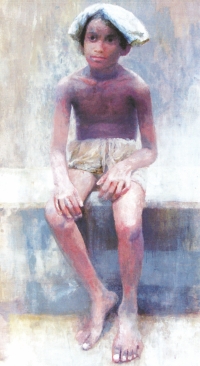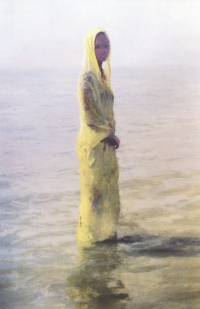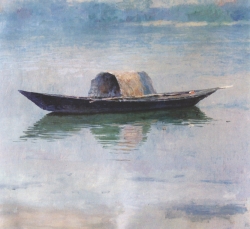| Home - Back Issues - The Team - Contact Us |
 |
| Volume 10 |Issue 45 | December 01, 2011 | |
|
|
Art The sun-kissed images of Oliver Fayza Haq
Miguel Oliver, 42, who comes from South of Spain, has come here, being motivated by master portrait painter, Shahid Kabir, who lives and works in Spain. Oliver is basically a student of architecture. He came to Bangladesh with his teacher, Shahid Kabir, last year. The lively, portrait painter from Southern, sunny Spain-- with Flamenco dancers with fans, outspread black skirts and kicking castanets-- believes in humanism. With dark, dancing pale-blue eyes, a ready smile, and repartee in English, he does not lengthen the vowels—as Europeans tend to be tagged with. Bright as a button, he stands-- with arms akimbo; and has an hour-long parley, without a break, elaborating on his figurative work-- most of which is based on Bangladesh. This includes Dhaka, and the places he has visited, which includes, Garo hills, and numerous river banks in various districts of the country. His solo twelve day exhibition began on November 26, at Gallery Chitrak's new venue at Road 6, House 4 at Mirpur Road. The exhibition is called “Bhulona Amay”. Zahir, Munir and Ahmed Nazir, three leading artist, directors of the gallery, stood as sentinels at the new venue. When Miguel Oliver elaborates on his portraits, he stresses on the human aspect of the individuals he has for his subjects. His narration is interesting, as he's obviously has delved deep into the personalities of the people, who have posed for him. They are ordinary everyday individuals—street flower sellers and people on the river banks, who've welcomed him with open arms — and given him food and drink, as people of the east, in the rural side, tend to do to visitors, specially from overseas. The artist's child subjects stand with stick in hand, like some opulent landlord, with beaming smile, a gaze of contentment. You'd never think that they are street urchins, who feed themselves and their ailing parents, by offering flowers and newspapers. The girl from the river bank, has a dress with colourful, vermilion red “shalwar” and the dress itself, trimmed with lace at the correct places. Her face is slightly sad, as if thinking about some lost friend, or teen aged boyfriend, who has gone to the city, and forgotten to write to her regularly, as he'd promised to do, when parting, as young Romeos and Juliets have been known to do.
Colourwise, the pictures tend to follow the French Impressionistic paintings, and the Dutch masters, like Rembrandt, combined with Shahid Kabir's eye for the beauty in common place things, such as grapes and bread or a beaker of drink — with care for presenting the table-cloth, the loveliness of the luscious purple grapes, the chiaroscuro effect on the subjects—whether they be objects or human portraits. It is the personality of the individual that Oliver has captured with his oil on canvas, as does also his teacher, Shahid Kabir, who has had many workshops, as in the Dhaka Art College, and joint exhibits in Bangladesh as in “Chitrak” and “Bengal” galleries. “The boy is someone I met two years back, when I first arrived at the airport. It was easy to do the portrait—as he was laughing all the times. Cheerfulness of the urchin impressed me most of all. His pride in himself was another element that impressed me,” says Oliver. “His disposition was that of a landlord, or some sort of moneyed personality. He was far from cringing and asking for a handout. I often made many sketches before I could put the brush on the canvas. The backdrop is slightly mauve and blue, while in the front, one finds scattered rose blossoms. The composition is one joy and harmony."
In another canvas, one finds the eternal crossing of the lady, asking the boatman, “Take me across the river, boatman. Please do”. The lines are well-loved part of songs, which are known from England to India. The beauty of man seen against nature, is a theme that inspires painters, from ages back, like the mother and child theme.
At times the artist has caught a scene, in which a festival, with water and rice, has taken place. The heaped rice plate and the half empty glass and clay pitchers speak of a festival which has taken place. The still life is a part of this moment in life, says Oliver, commenting on another still-life piece, where harmony and tranquility are the essence of the images. Similarly, a composition with an old kettle, some onions and a knife, create warm, homely images of contentment and family life, as is found in so many of Shahid Kabir's works. One portrait is that of the sister of Shahid Kabir, whom Oliver has known over decades. This image of the delectable lady, with large luminous eyes, cupid lips, curling long jet-black tresses, complete with a large mole on the cheek has been inspired by an old photograph. “She walks in beauty,' as the Romantic poet put it. She looked after her family with a mother's affection and tenderness. She died of cancer about seven years back, says Oliver. He adds that this kind of family ties and caring still survives in Bangladesh, and this country is rampant with close family ties. Modernisation and industrialisation has not taken the whole of the country. The warmth of the hearth and home still exists here. Whether the painter dwells on the scene of a bargeman taking home his pots, pans, bedding and other earthly possessions — or recreating Kabi Guru Rabindranath Tagore, who was a friend of the Spanish poet Gracia Lorca, the brush has done a heart-felt work. Bravo, Oliver. Art is in the mind and heart, believes Oliver. His exhibitions have been held in Mexico, Cost Rica, Argentina, Madrid, Cadiz, New York, Shanghai etc. Copyright
(R) thedailystar.net 2011 |


